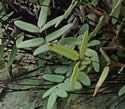Pellaea glabella (Smooth Cliff Brake)
| Also known as: | |
|---|---|
| Genus: | Pellaea |
| Family: | Pteridaceae (Maidenhair) |
| Life cycle: | perennial |
| Origin: | native |
| Habitat: | part shade, sun; limestone or dolomite outcrops, cliffs, bluffs |
| Fruiting season: | summer |
| Plant height: | 1 to 15 inches |
| Wetland Indicator Status: | none |
| MN county distribution (click map to enlarge): |  |
| National distribution (click map to enlarge): |  |
Pick an image for a larger view. See the glossary for icon descriptions.
Detailed Information
Leaves and stems: 

![[photo of frond]](/udata/r9ndp23q/pd3/pellaea-glabella-9173-45-t.jpg) Leaves (fronds) are evergreen, 1 to 15 inches long (typically less than 10) and to 3 inches wide, once or twice compound with 4 to 9 pair of leaflets (pinnae). Only the lower pinnae are twice compound or sometimes merely lobed in 2 or 3 segments. Pinnae and lobes are lance-oblong to linear, leathery, blue-green, the lower pinnae short-stalked, the upper pinnae stalkless.
Leaves (fronds) are evergreen, 1 to 15 inches long (typically less than 10) and to 3 inches wide, once or twice compound with 4 to 9 pair of leaflets (pinnae). Only the lower pinnae are twice compound or sometimes merely lobed in 2 or 3 segments. Pinnae and lobes are lance-oblong to linear, leathery, blue-green, the lower pinnae short-stalked, the upper pinnae stalkless.
![[photo of pinnae underside, with a few hairs]](/udata/r9ndp23q/pd3/pellaea-glabella-9173-13-t.jpg) Pinnae are hairless except sometimes for a few hairs on the underside near the midrib; veins are obscure. Stems are uniformly dark brown to purplish, slender, shiny, and smooth except for scattered hair-like scales. Plants grow spreading to sprawling in an asymmetrical clump, the withered remains often persisting to the next season. Fertile and sterile fronds are similar in size and shape.
Pinnae are hairless except sometimes for a few hairs on the underside near the midrib; veins are obscure. Stems are uniformly dark brown to purplish, slender, shiny, and smooth except for scattered hair-like scales. Plants grow spreading to sprawling in an asymmetrical clump, the withered remains often persisting to the next season. Fertile and sterile fronds are similar in size and shape.
Spores: 
![[photo of spores]](/udata/r9ndp23q/pd3/pellaea-glabella-9173-41-t.jpg) The sori (group of spores) develop on fertile fronds starting in early summer and are found on the underside of a leaflet along the edge, the leaflet edge rolled around them so most are unexposed.
The sori (group of spores) develop on fertile fronds starting in early summer and are found on the underside of a leaflet along the edge, the leaflet edge rolled around them so most are unexposed.
Notes:
Smooth Cliff Brake is a fairly distinctive species, the only one really similar is the rare Purple Cliff Brake (Pellaea atropurpurea), found only in 4 counties in the southeast corner of the state. Purple Cliff Brake has rather larger pinnae, densely hairy/scaly stems, and typically grows erect, where Smooth Cliff Brake has—you guessed it—smooth stems, barring a few sparse hairs, and is more spreading/sprawling. Depending on the reference, there are up to 4 subspecies (or varieties) of P. glabella, distinguished mostly by the number of spores in a group (32 or 64—go ahead, count them) and the hairiness of the pinnae. The species is widespread in North America with the subspecies having more regional distributions; subsp. glabella is found in Minnesota and we are on the western edge of its range.
Native Plant Nurseries, Restoration and Landscaping Services ↓
More photos
 Smooth Cliff Brake plant
Smooth Cliff Brake plant Smooth Cliff Brake plants
Smooth Cliff Brake plants Smooth Cliff Brake plants
Smooth Cliff Brake plants persistent old stems
persistent old stems young frond
young frond growing in the cracks
growing in the cracks
Photos courtesy Peter M. Dziuk taken at Lost Valley SNA, Washington County, and in Fillmore and Winona counties.
Comments
Have you seen this plant in Minnesota, or have any other comments about it?
on: 2015-07-29 13:10:14
This darling little plant has taken residence in the limestone cracks on the Stone Arch Bridge.
on: 2020-08-29 16:39:32
Found in the cracks of a retaining wall on Olive st. (Next to Main st.) in Stillwater.






